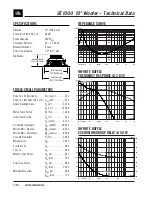
•
From the receiver or pre/pro's speaker cali-
bration menu, set the subwoofer level to
0dB. Start with the gain on the subwoofer
around 1/4 to 1/2 of the way up from the -15
mark.
•
In the speaker configuration menu, be sure
all your speakers are set to “small” with sub-
woofer to "yes". For this exercise, the cross-
over should be set to 80Hz.
•
Set the volume control on your pre/pro or
receiver to the "00 dB" level. See the note
below if your unit uses a positive number
scale for volume instead of a minus-to-plus
scale.
•
Ensure that all main, center, and rear chan-
nels are calibrated to the reference point us-
ing your test tones, then direct the tone to
the subwoofer. Adjust it's level using the
gain control on the subwoofer itself until it
reaches the sound pressure level used for the
other speakers.
An assistant is very helpful in this process.
Some like to run their sub a bit louder (“hot”) for
movies by increasing the sub level (in the re-
ceiver’s control panel) by 5dB or so above the
main channel level. This can be very effective at
lower listening levels, but be sure to use care
when watching that big action movie for the first
time...especially at or near reference levels!
Once the subwoofer is calibrated, small adjust-
ments can be made easily using the subwoofer
level control in your processor. If you find the
need to go much above +2 or +3 consistently,
we recommend adjusting the gain control on the
sub’s amplifier upward rather than using the re-
ceiver’s volume control—this will eliminate the
possibility of the subwoofer receiving a distorted
input signal. Conversely, using too low of a
value for the subwoofer level on the processor
may result in difficulty keeping the subwoofer's
auto-on feature "awake" during quiet passages.
Note: If your unit does not use a minus/plus vol-
ume scale, activate the test tones and increase
the volume of your pre/pro or receiver until it
reaches 75dB or 85dB on your SPL meter. Re-
member this number as this will be “reference
level*.” Remember to check with your unit’s
manual to determine if they use a 75dB or 85dB
test tone.
*What is reference level? Reference
level allows for peaks of 105dB from the
speakers and 115dB for the LFE channel.
When calibrated as above, the correct
relative volume of each speaker will be
as the director/sound engineer of the
film intended.
4.3 Crossover Settings
Your UFW-10 Subwoofer features a defeatable,
continuously variable crossover that allows you
to set a low-pass filter at any point between
40Hz and 150Hz. In addition, many popular re-
ceivers and surround processors also feature
built-in electronic crossovers (please consult your
receiver’s instruction manual). If present, we
recommend using your receiver’s crossover and
setting the UFW’s crossover switch to “out” thus
disabling this feature.
After setup is completed, during which an 80Hz
crossover is recommended, you can adjust your
crossover accordingly either in the subwoofer it-
self or as recommended in your receiver’s setup
menu. Typically, the smaller your speaker OR
the louder the system will be played, the higher
the crossover point. Conversely, larger speakers
OR lower volumes allow for lower crossover set-
tings. The THX standard, and the recommended
crossover with your UFW-10 is 80Hz for home
theater.
4.4 UFW-10 Phase Adjustment
The phase dial (see “I” on figure 1.1) controls
the relative phase of the subwoofer to best rein-
force the other loudspeakers in your system.
Adjustments to this control will change your
UFW-10’s interaction with the rest of your
speaker system, providing the least cancellation,
and thus the best response in any room. With
SPL meter in hand (or, better yet, on a tripod),
play an 80Hz tone (for this exercise the cross-
over point must be set to 80Hz) and slowly ro-
tate the phase control from "0" towards “180.”
Watching your SPL meter, find the point that re-
sults in the biggest peaks in sound pressure lev-
els (i.e. reads highest on the meter). This set-
ting indicates the least amount of bass wave can-
cellation, and should be held constant until the
subwoofer or other speakers in your room are
moved, or placement is altered in any way. With






























